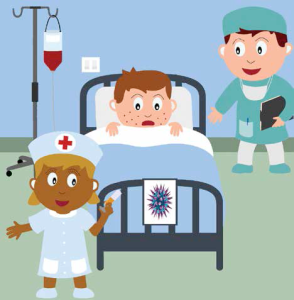
 International Infection Prevention Week (IIPW) is celebrated between October 20-26. It is a timely reminder of the deadly and dangerous bacteria and viruses lurking in our hospitals. In India, hospital infection rate is almost 25 percent. Here hospital acquired infections kill more people than any other form of accidental death. Stay informed with ShahidAkhter, ENN
International Infection Prevention Week (IIPW) is celebrated between October 20-26. It is a timely reminder of the deadly and dangerous bacteria and viruses lurking in our hospitals. In India, hospital infection rate is almost 25 percent. Here hospital acquired infections kill more people than any other form of accidental death. Stay informed with ShahidAkhter, ENN
| Quick Facts 80 percent of infectious diseases are transferred by touch Globally, hospital acquired infections affect more than 1.4 million patients in a year Bloodstream infections related to Central Venous catheterisation are the most common device-associated infections 45-50 percent of stopcocks are contaminated and could allow potential entry of micro-organisms One out of every four catheter may be occluded |

Hospital acquired infections, until recently, were considered as side effects or inevitable risks of healthcare and hospitals were woefully underprepared to tackle them. Today there is no second thought about the possibility of prevention for nearly all types of hospital infections. We all are aware of the science behind infections and prevention. Despite this, hospitals have failed to comply with norms and this allows the infection rates to percolate alarmingly to over 60 percent.
On the other end of the spectrum lie countries like Finland and Denmark, that have been successful in keeping HAI rates below one percent. No scientific breakthrough knowledge is required to achieve this target. The marvel behind the miracle lies in rigorous hand hygiene, cleaning of equipments and other preventive measures.
Poor Hygiene
Patients room are often contaminated with MRSA (methicillin-resistant S aureus) and VRE (vancomycin-resistant enterococci). These bacteria are known to linger on environmental surfaces of the bed rails, bedside tables or any similar surface. One touch by the patient or the doctor or any other health provider makes them prone to victims and vectors for disease. The solution lies in hygiene.
Besides the unsuspecting surfaces, the other sources of bacteria are the patients entering the hospital. Do we test the incoming patients? Absolutely not.
Do the doctors bother to clean their stethoscopes, pulse oximeters, blood pressure cuffs and similar array of gadgets? Possibly not.
Routine interaction with the infected patients may result in picking up the bacteria through the white coats and uniforms and these may be passed on to other patients or may harm the caregivers themselves. Do we take steps to prevent this spread of bacteria through clothing? Certainly not.
How frequently and properly do the healthcare givers wash their hands and ensure cleanliness? This little issue has garnered the most attention today. Hospitals have installed secret observers to monitor their doctors; wrist bands have been developed to warn healthcare works if they have washed their hands properly. Have you?
The simple solution lies in good housekeeping and the will to take little, life-saving precautions.
Transmission Routes
The chief transmission avenues of hospital-acquired infections are through contact, droplet, airborne and common-vehicle.
The most common is the contact transmission which is most preventable. Direct contact involves body to body surface contact that facilitates the transfer of microorganisms. Indirect contact involves body surface contact with contaminated objects. This usually happens when person gives the patient a bath or other patient care activities that involves direct personal contact. These transmissions can be substantially reduced by hand hygiene, ie washing.
Droplet transmission takes affect when droplets containing infected microorganisms travel through the air and reach the mouth, eyes or nose of another person. This usually happens during coughing, sneezing or talking. When these droplets evaporate and remain in the air for long it leads to airborne transmission which occurs with dust particles containing infectious agents. Covering the face or at least the nose, mouth and eyes is the only solution.
Besides these, some common vehicles of transmission include food, water, medications and devices that have been contaminated.
Be a part of Elets Collaborative Initiatives. Join Us for Upcoming Events and explore business opportunities. Like us on Facebook , connect with us on LinkedIn and follow us on Twitter , Instagram.












